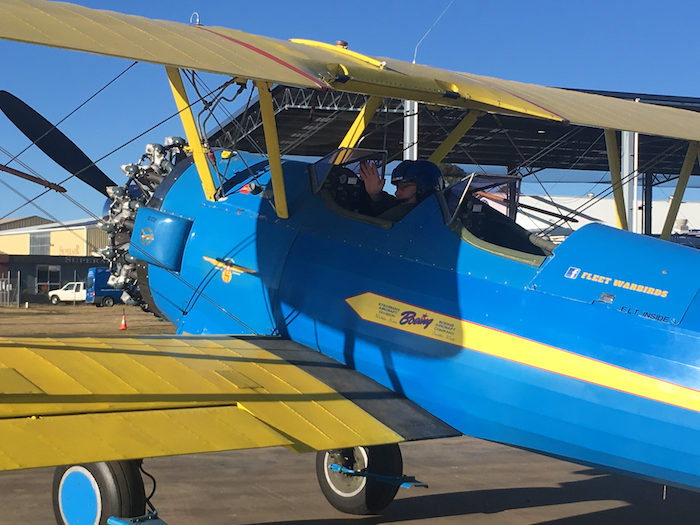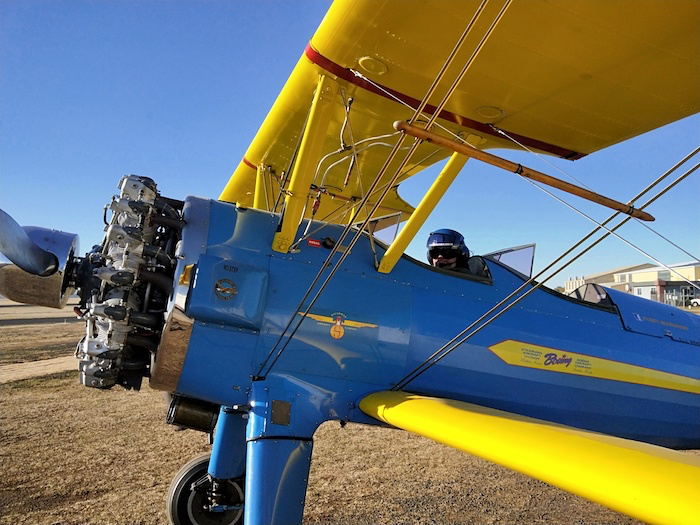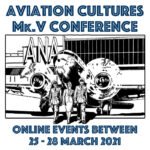
This a Boeing (Stearman) Model 75, built in 1941 for use as a primary trainer for the US Army Air Forces. After a postwar career in the US as a cropduster, it was registered in Australia as VH-JLW and is now operated by Fleet Adventures, based at Armidale Regional Airport. And last Friday, as a surprise, and very touching, farewell present from my friends (aided and abetted by my partner), I flew in it!

This was for fun, not for research. And it was indeed hugely fun, flying through Dangars Gorge, over Armidale and the University of New England, my (now former!) workplace. But inevitably, flying for the first time in a vintage open-cockpit biplane, I did think about how this experience connected with that of early aviators and their passengers. Many people experience flight these days, but the vast majority of them don’t experience it like this, something like the joyflights offered by itinerant barnstormers when they came to town and took up as many adventurous locals as were willing to pay before moving on.

The flight came just a few days after a minor Twitter storm over a speech by Allan Mallinson, a former British Army officer who now writes historical fiction and military history, in which he said that ‘Military History has been colonised by young academics with no experience of soldiering’. He partially rectified this by adding ‘That’s great; they can establish the facts’, which is a bit better, but is still faintly dismissive while still missing the point of academic history. Military history is too important to be left to the military; war affects far more than the people doing the fighting; if we can only write the history of things we’ve directly experienced then most historiography goes out the window. If I have to go through an air raid in order to write about the fear of bombing, then I may as well shut up shop right now, because it’s not going to happen! (I hope…)

All of this is not to say, however, that having been a soldier is not a valuable perspective to bring to military history. It’s just not necessary (and certainly not sufficient). Besides, there are other perspectives which are useful. One which has certainly informed my PhD research was having lived through the early 1980s — the era of Threads, WarGames, ‘Two Tribes’, and a terrifyingly intensified threat of nuclear war. A few days ago I realised I had another, one more relevant to my joyflight and to airmindedness in general. In the mid-1990s, I was an astrophysics postgraduate student at the University of Melbourne, which meant I had access to AARnet, effectively the Australian part of the Internet. I was soon drawn in to exploring Gopher sites, anonymous FTP servers and Usenet groups. I was using the World Wide Web by August 1993 at the latest (I emailed a friend that ‘you can find all of this sort of stuff with the cern web (telnet info.cern.ch and choose options 1 and then 25 … )’ — apparently swapping telnet sites was something people did back then). That June, Wanderer, the first webcrawler, had found only 130 websites. I set up my own first website in June 1994, as announced in sci.astro.research, and the NCSA What’s New page:
A home page devoted to the 1995 Gravitational Lensing Conference is now available at the WWW server of the School of Physics at the University of Melbourne, Australia. The conference will discuss important recent advances in the astrophysics of gravitational lenses, including, but not limited to, microlensing, quasar/galaxy associations, gamma-ray bursts, MACHOs, Hubble observations and large-scale structure in the Universe.
The School didn’t have a website itself yet, so I set that up too. That same month, Wanderer found 2738 websites, so again, this is quite early in the history of the web. (In June 2018, Netcraft found 1.6 billion, though many caveats apply.) Despite some initial scepticism (Gopher had much more content, and a GUI!), I soon became a regular web evangelist, which is to say rather a bore to all my friends on the topic. So, I was part of a culture of prophetic technological enthusiasts, who thought the coming of the Internet in general and the World Wide Web in particular was going to change the world. Everyone now knows how the rest of that story turned out, for good or for ill. But my point is that this should sound familar, because if you replace the computers with aeroplanes and go back in time 50 or 75 years (and okay, make a few other changes), you’ve got airmindedness. Which is where I come in — except that in a way, I was already there.
Image credits: Sarah Lawrence, Nathan Wise.
![]() This work is licensed under a Creative Commons Attribution-NonCommercial-NoDerivatives 4.0 International License.
Permissions beyond the scope of this license may be available at http://airminded.org/copyright/.
This work is licensed under a Creative Commons Attribution-NonCommercial-NoDerivatives 4.0 International License.
Permissions beyond the scope of this license may be available at http://airminded.org/copyright/.




Best of luck on your return to Melbourne, and felicitations if you’re not being coy.
That out of the way, who the heck is John Pomeroy?
https://www.flightglobal.com/pdfarchive/view/1948/1948%20-%200703.html
I don’t think I was being coy; at any rate, thank you!
John Pomeroy was a New Zealand inventor. I suspect the ‘Pomeroy missile’ in that article should be taken to refer to the Pomeroy explosive anti-Zeppelin ammunition: see here and here for more.